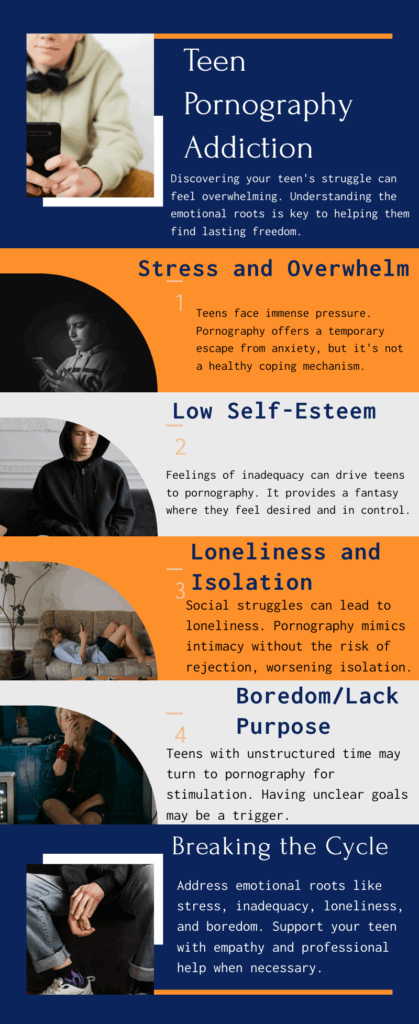Discovering your teen’s struggle with pornography addiction can feel like navigating uncharted territory as a parent. You might question whether it’s a passing phase, a spark of curiosity, or a deeper issue. Like a baseball—smooth on the surface with complex layers of yarn and cork inside—or a tree, with roots hidden deep in the soil, your teen’s behavior has unseen drivers. Pornography addiction often stems from emotional triggers like stress, loneliness, or inadequacy, fueling a cycle that’s hard to break. The Star Guides therapy process offers a structured, evidence-based program for pornography addiction, helping teens address these roots and find lasting recovery. This post explores why pornography takes hold, the emotional triggers behind it, and practical strategies, including resources for porn addiction, to guide your teen toward healthier coping mechanisms.
The Hidden Roots of Pornography Addiction
While curiosity or hormones may spark initial pornography use, they don’t explain why it becomes compulsive. A 2022 study in Psychology of Addictive Behaviors found that teens using pornography to cope with negative emotions are 35% more likely to relapse if those emotions go unaddressed. The Star Guides therapy process emphasizes identifying these emotional drivers to disrupt the addiction cycle. This cycle—triggered by a cue (like stress), leading to a craving, behavior (watching pornography), and temporary relief—can grip teens quickly due to their still-developing brains. The prefrontal cortex, which governs impulse control, isn’t fully mature until the mid-20s, making teens vulnerable to reward-driven habits like pornography.
Why does pornography become an escape?
It’s private, accessible, and delivers a quick dopamine hit, unlike healthier outlets like exercise or confiding in a friend. However, this temporary “fix” often deepens feelings of shame or disconnection, restarting the cycle. The Star Guides therapy process, a specialized program for pornography addiction, helps teens break this cycle by addressing emotional triggers and building resilience through tailored interventions.
Emotional Triggers Fueling Pornography Addiction
Pornography often serves as a temporary escape from emotional discomfort. The Star Guides therapy process helps teens and families identify and manage these triggers, offering resources for porn addiction to support recovery. Here are four common emotional drivers, backed by research, and actionable steps to address them:
- Stress and Overwhelm
Teens face intense pressures—school, social dynamics, and future uncertainties. A 2021 Frontiers in Psychiatry study linked chronic stress to compulsive behaviors like pornography use. The Star Guides therapy process teaches teens to replace pornography with healthy stress management techniques. How to Help:
- Open Dialogue: Create a nonjudgmental space to discuss stress. Ask, “What’s been tough lately?” and listen without judgment.
- Teach Coping Skills: Introduce mindfulness, journaling, or physical activity. The Star Guides program for pornography addiction incorporates these tools to reduce reliance on harmful escapes.
- Model Behavior: Show your teen how you manage stress positively, reinforcing healthy habits.
- Feelings of Inadequacy or Low Self-Esteem
Teens grappling with feelings of not being “enough” may turn to pornography for a fleeting sense of control or validation. However, its unrealistic portrayals can worsen self-esteem. The Star Guides therapy process builds confidence through therapeutic activities and group support.How to Help:
- Affirm Their Value: Highlight your teen’s strengths with specific praise, like, “I admire your persistence in that challenge.”
- Encourage Activities: Enroll them in sports or hobbies to boost self-worth. The Star Guides program uses experiential therapies, like outdoor activities, to foster confidence.
- Challenge Comparisons: Discuss how pornography and social media distort reality, encouraging critical thinking.
- Loneliness and Isolation
Loneliness can drive teens to pornography as a substitute for connection. A 2023 Computers in Human Behavior study linked social isolation to problematic internet use. The Star Guides therapy process creates a supportive community to combat isolation.
How to Help:
- Build Connections: Encourage participation in clubs or family activities. Star Guides offers group therapy to foster peer support.
- Validate Feelings: Acknowledge loneliness with empathy: “I see you’re feeling alone, and I’m here.”
- Limit Screens: Set boundaries, like no devices during meals, to promote real-world interaction.
- Boredom or Lack of Purpose
Boredom can lead to pornography use for stimulation. A 2019 Psychology of Popular Media study found that boredom-prone teens are more likely to engage in compulsive online behaviors. The Star Guides program for pornography addiction provides structure and purpose through goal-oriented activities. How to Help:
- Spark Passion: Help your teen explore hobbies like art or sports. Star Guides integrates adventure therapy to engage teens.
- Create Routine: Establish a balanced schedule to reduce idle time.
- Set Goals: Celebrate small achievements to build purpose, a key component of the Star Guides therapy process.
Breaking the Cycle with the Star Guides Therapy Process
The Star Guides therapy process is a comprehensive program for pornography addiction, combining wilderness therapy, individual counseling, and group support to address both behavior and emotional roots. Here’s how parents can support their teens’ recovery with resources for porn addiction:
- Approach with Empathy: Shame fuels addiction. The Star Guides therapy process emphasizes nonjudgmental support. Say, “I know this is hard, and we’ll work through it together.” A 2021 Journal of Sexual Research study found that empathy increases teens’ willingness to seek help.
- Set Healthy Boundaries: Use filtering software and limit private device use, framing these as supportive tools. Star Guides provides a tech-free environment to reset habits.
- Seek Professional Support: The Star Guides program for pornography addiction uses cognitive-behavioral therapy (CBT) and wilderness therapy to address triggers, as supported by a 2020 Journal of Behavioral Addictions study.
- Build a Support Network: Encourage connections with mentors or peers. Star Guides fosters accountability through group therapy and community living.
- Educate on Relationships: Counter pornography’s distortions with conversations about healthy intimacy. Star Guides offers workshops on respect and consent.
The Path to Recovery with Star Guides
Pornography addiction is complex, but the Star Guides therapy process provides a clear path to recovery. By addressing emotional triggers—stress, inadequacy, loneliness, or boredom—this program for pornography addiction empowers teens to break free from the cycle. Recovery takes time, but with parental support and professional guidance, your teen can build a healthier future.If you’re feeling overwhelmed, resources for porn addiction are available. The Star Guides therapy process, offered at Star Guides Treatment Center, combines evidence-based therapy with immersive experiences to address addiction holistically. Visit their website for details.
Additional Resources for Porn Addiction:
- Recovery Toolbox for Teens Recovery Toolbox For Teens | Therapyassociates
- Therapy Associates Counseling Services Pornography Addiction | Therapy Associates
- Star Guides Treatment Center (https://starguides.net/)
By leveraging the Star Guides therapy process and these resources for porn addiction, you’re not just addressing a behavior—you’re helping your teen develop resilience and emotional strength for life.


